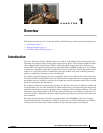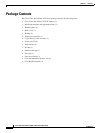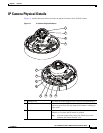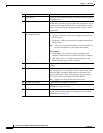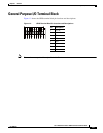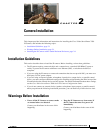
1-4
Cisco Video Surveillance 7030 IP Camera Installation Guide
OL-28692-01
Chapter 1 Overview
IP Camera Physical Details
4 Tilt adjustment screw Used when tilting the camera to set the field of view.
5 Light sensor Senses the level of ambient light to determine when to switch
day/night mode.
6 Recessed reset button Recessed button that reboots the IP camera or resets it to a
default state. You can use a pin or paper clip to depress it. It can
be used any time that the IP camera is on and can have various
effects, as described in the “Resetting the IP Camera” section
on page 2-11.
7 External microphone and
video output switches
External microphone
• Off (up)—disables an external microphone connected to
the IP camera.
• On (down)—enables an external microphone connected to
the IP camera.
Note There is no internal microphone. You must connect an
external microphone if you require audio inputs.
Video output
• NTSC 60Hz (up)—switches camera operation to the
National Television System Committee (NTSC) standard.
• PAL 50Hz (down)—switches camera operation to the
Phase Alternating Line (PAL) standard.
8 Micro SD/SDHC card slot Support for the SD/SDHC card slot will be available in future
releases.
9 Audio/Video out (green) Allows the connection of an optional Y cable or mini cable with
BNC connector. You can connect a video monitor to the mini
cable with BNC connector. Both cables are included in the
optional audio/video cables accessory kit can be purchased
from Cisco (Cisco part number CIVS-AVCABLE).
Note Support for audio will be in future releases.
10 Microphone In (pink) Connection for an external microphone.
11 Ethernet 10/100 RJ45 socket Accepts a standard LAN cable to connect the IP camera to a
10/100BaseT router or switch.
12 GPIO Block General purpose input/output (GPIO) terminal block that is
used to connect external input and output devices. For more
information, see
Figure 1-2.








